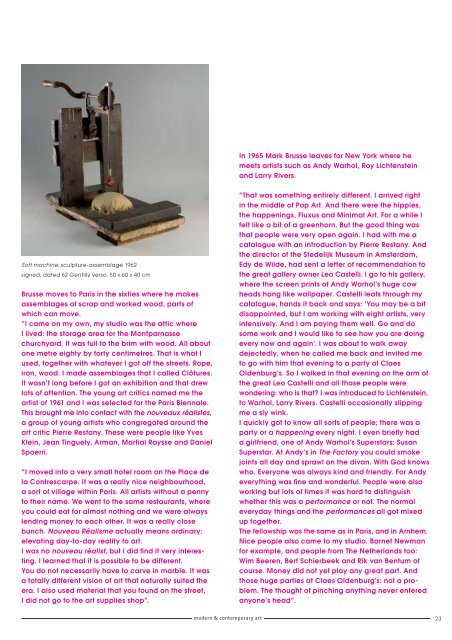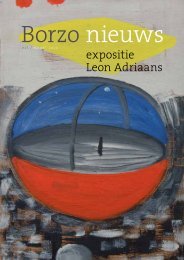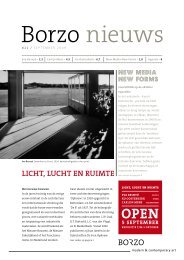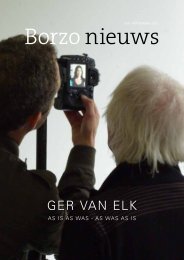nieuw realisme en pop art uit de jaren 60 - Borzo
nieuw realisme en pop art uit de jaren 60 - Borzo
nieuw realisme en pop art uit de jaren 60 - Borzo
You also want an ePaper? Increase the reach of your titles
YUMPU automatically turns print PDFs into web optimized ePapers that Google loves.
Soft machine, sculpture-assemblage 1962<br />
signed, dated 62 G<strong>en</strong>tilly verso, 50 x <strong>60</strong> x 40 cm<br />
Brusse moves to Paris in the sixties where he makes<br />
assemblages of scrap and worked wood, p<strong>art</strong>s of<br />
which can move.<br />
“I came on my own, my studio was the attic where<br />
I lived: the storage area for the Montparnasse<br />
churchyard. It was full to the brim with wood. All about<br />
one metre eighty by forty c<strong>en</strong>timetres. That is what I<br />
used, together with whatever I got off the streets. Rope,<br />
iron, wood. I ma<strong>de</strong> assemblages that I called Clôtures.<br />
It wasn’t long before I got an exhibition and that drew<br />
lots of att<strong>en</strong>tion. The young <strong>art</strong> critics named me the<br />
<strong>art</strong>ist of 1961 and I was selected for the Paris Bi<strong>en</strong>nale.<br />
This brought me into contact with the nouveaux réalistes,<br />
a group of young <strong>art</strong>ists who congregated around the<br />
<strong>art</strong> critic Pierre Restany. These were people like Yves<br />
Klein, Jean Tinguely, Arman, M<strong>art</strong>ial Raysse and Daniel<br />
Spoerri.<br />
“I moved into a very small hotel room on the Place <strong>de</strong><br />
la Contrescarpe. It was a really nice neighbourhood,<br />
a sort of village within Paris. All <strong>art</strong>ists without a p<strong>en</strong>ny<br />
to their name. We w<strong>en</strong>t to the same restaurants, where<br />
you could eat for almost nothing and we were always<br />
l<strong>en</strong>ding money to each other. It was a really close<br />
bunch. Nouveau Réalisme actually means ordinary:<br />
elevating day-to-day reality to <strong>art</strong>.<br />
I was no nouveau réalist, but I did fi nd it very interesting.<br />
I learned that it is possible to be differ<strong>en</strong>t.<br />
You do not necessarily have to carve in marble. It was<br />
a totally differ<strong>en</strong>t vision of <strong>art</strong> that naturally s<strong>uit</strong>ed the<br />
era. I also used material that you found on the street,<br />
I did not go to the <strong>art</strong> supplies shop”.<br />
mo<strong>de</strong>rn & contemporary <strong>art</strong><br />
In 1965 Mark Brusse leaves for New York where he<br />
meets <strong>art</strong>ists such as Andy Warhol, Roy Licht<strong>en</strong>stein<br />
and Larry Rivers.<br />
“That was something <strong>en</strong>tirely differ<strong>en</strong>t. I arrived right<br />
in the middle of Pop Art. And there were the hippies,<br />
the happ<strong>en</strong>ings, Fluxus and Minimal Art. For a while I<br />
felt like a bit of a gre<strong>en</strong>horn. But the good thing was<br />
that people were very op<strong>en</strong> again. I had with me a<br />
catalogue with an introduction by Pierre Restany. And<br />
the director of the Ste<strong>de</strong>lijk Museum in Amsterdam,<br />
Edy <strong>de</strong> Wil<strong>de</strong>, had s<strong>en</strong>t a letter of recomm<strong>en</strong>dation to<br />
the great gallery owner Leo Castelli. I go to his gallery,<br />
where the scre<strong>en</strong> prints of Andy Warhol’s huge cow<br />
heads hang like wallpaper. Castelli leafs through my<br />
catalogue, hands it back and says: ‘You may be a bit<br />
disappointed, but I am working with eight <strong>art</strong>ists, very<br />
int<strong>en</strong>sively. And I am paying them well. Go and do<br />
some work and I would like to see how you are doing<br />
every now and again’. I was about to walk away<br />
<strong>de</strong>jectedly, wh<strong>en</strong> he called me back and invited me<br />
to go with him that ev<strong>en</strong>ing to a p<strong>art</strong>y of Claes<br />
Old<strong>en</strong>burg’s. So I walked in that ev<strong>en</strong>ing on the arm of<br />
the great Leo Castelli and all those people were<br />
won<strong>de</strong>ring: who is that? I was introduced to Licht<strong>en</strong>stein,<br />
to Warhol, Larry Rivers. Castelli occasionally slipping<br />
me a sly wink.<br />
I quickly got to know all sorts of people; there was a<br />
p<strong>art</strong>y or a happ<strong>en</strong>ing every night. I ev<strong>en</strong> briefl y had<br />
a girlfri<strong>en</strong>d, one of Andy Warhol’s Superstars: Susan<br />
Superstar. At Andy’s in The Factory you could smoke<br />
joints all day and sprawl on the divan. With God knows<br />
who. Everyone was always kind and fri<strong>en</strong>dly. For Andy<br />
everything was fi ne and won<strong>de</strong>rful. People were also<br />
working but lots of times it was hard to distinguish<br />
whether this was a performance or not. The normal<br />
everyday things and the performances all got mixed<br />
up together.<br />
The fellowship was the same as in Paris, and in Arnhem.<br />
Nice people also came to my studio. Barnet Newman<br />
for example, and people from The Netherlands too:<br />
Wim Beer<strong>en</strong>, Bert Schierbeek and Rik van B<strong>en</strong>tum of<br />
course. Money did not yet play any great p<strong>art</strong>. And<br />
those huge p<strong>art</strong>ies at Claes Old<strong>en</strong>burg’s: not a problem.<br />
The thought of pinching anything never <strong>en</strong>tered<br />
anyone’s head”.<br />
23





